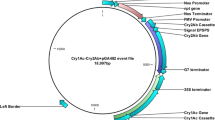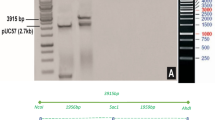Abstract
Here we describe development of transgenic elite rice lines expressing a Bt fusion gene derived from cryIA(b) and cryIA(c) under the control of rice actinI promoter. The lines used in the study were indica CMS restorer line of Minghui 63 and its derived hybrid rice Shanyou 63. The level of Bt fusion protein CryIA(b)/CryIA(c) detected in Minghui 63 (T51-1) plants was 20 ng/mg soluble protein. The Bt Shanyou 63 was field-tested in natural and repeated heavy manual infestation of two lepidopteran insects, leaffolder and yellow stem borer. The transgenic hybrid plants showed high protection against both insect pests without reduced yield.
This is a preview of subscription content, access via your institution
Access options
Subscribe to this journal
Receive 12 print issues and online access
$209.00 per year
only $17.42 per issue
Buy this article
- Purchase on Springer Link
- Instant access to full article PDF
Prices may be subject to local taxes which are calculated during checkout



Similar content being viewed by others
References
Yuan, L.P. Hybrid rice in China. In Hybrid rice technology (eds Ahmed, M.I., Viraktamath, B.C. & Vijaya, C.H.M.) 51–54 (Directorate of Rice Research, Rajendranagar, Hyderabad, India; 1996).
Virmani, S. S. Hybrid rice. Adv. Agron. 57, 328–462 (1996).
Duvick, D.N. Heterosis: feeding people and protecting natural resources. In The genetics and exploitation of heterosis in crops (eds James, G. & Shivaji Pandey) 19–29 (ASA-CSSA-SSSA, Madison, WI; 1999)
Mew, T.W., Wand, F.M., Wu, J.T., Lin, K.R. & Khush, G.S. Disease and insect resistance in hybrid rice. In Hybrid rice 189–200 (IRRI, Manila, Philippines; 1988).
Tian, L.R. & Li, X.K. Managing disease and insect pests of hybrid rice in China. In Hybrid technology: new developments and future prospects—selected papers from the International Rice Research Conference (ed. Virmani, S.S.) 115–122 (IRRI, Los Baños, Manila, Philippines; 1994).
Teng, P.S. & Revilla, I.M. Technical issues in using crop-loss for research prioritization. In Rice research in Asia: progress and priorities (eds Evenson, R.E., Herdt. R.W. & Hossain, M.) 261–275 (CAB International in association with International Rice Research Institute, Wallingford, UK; 1996).
Frutos, R., Rang, C. & Royer, M. Managing insect resistance to plants producing Bacillus thuringiensis toxins. Crit. Rev. Biotechnol. 19, 227–276 (1999).
MacIntosh, S.C. et al. Specificity and efficacy of purified Bacillus thuringiensis proteins against agronomically important insects. J. Invert. Pathol. 56, 258–266 (1998).
Adang, M.J. et al. Characterized full-length and truncated plasmid clones of the crystal protein of Bacillus thuringiensis ssp. kurstaki HD-73 and their toxicity to Manduca sexta. Gene 36, 289–300 (1985).
Perlak, F.J. et al. Insect-resistance cotton plants. Bio/Technology 8, 939–943 (1990).
Potrykus, I. Gene transfer to cereals: an assessment. Bio/Technology 8, 535–542 (1990).
Datta, S.K., Datta, K., Soltanifer, N., Donn, G. & Potrykus, I. Genetically engineered fertile indica rice recovered from protoplasts. Bio/Technology 8, 736–740 (1990).
Christou, P., Ford, T.M. & Kofton, M. Production of transgenic rice (Oryza sativa L.) plants from agronomically important indica and japonica varieties via electric discharge particle acceleration of exogenous DNA into immature zygotic embryos. Bio/Technology 9, 957–962 (1991).
Pinto, Y.M., Kok, R.A. & Baulcombe, D.C. Resistance to rice yellow mottle virus (RYMV) in cultivated African rice varieties contains RYMV transgenes. Bio/Technology 17, 702–707 (1999).
Li, L., Gu, R., Kochko, A.D., Fauquet, C. & Beachy, R.N. An improved rice transformation system using the biolistic method. Plant Cell Rep. 12, 250–255 (1993).
Vasil, I.K. Molecular improvement of cereals. Plant Mol. Biol. 25, 925–937 (1994).
Höfte, H. & Whiteley, H.R. Insecticidal crystal proteins of Bacillus thuringiensis. Microbiol. Rev. 53, 242–255 (1989).
Schnepf, E. et al. Bacillus thuringiensis and its pesticidal crystal proteins. Microbiol. Mol. Biol. Rev. Sept. 775–806 (1998).
Vaeck, M. et al. Transgenic plants protected from insect attack. Nature 327, 239–247 (1987).
Delannay, X. et al. Field performance of transgenic tomato plants expressing the Bacillus thuringiensis var. kurstaki insect control protein. Bio/Technology 7, 1265–1269 (1989).
Barton, K.A., Whiteley, H.R. & Yang, N.-S. Bacillus thuringiensis expressed in transgenic Nicotiana tabacum provides resistance to lepidopteran insects. Plant Physiol. 85, 1103–1109 (1987).
Stewart, C.N. Jr. et al. Insect control and dosage effect in transgenic canola containing a synthetic Bacillus thuringiensis cryIAc gene. Plant Physiol. 112, 115–120 (1996).
Fujimoto, H., Itoh, K., Yamamoto, M., Kyozuka, J. & Shimamoto, K. Insect-resistant rice generated by introduction of a modified δ-endotoxin gene of Bacillus thuringiensis. Bio/Technology 11, 1151–1155 (1993).
Wünn, J. et al. Transgenic indica rice breeding line IR58 expressing a synthetic cryIA(b) gene from Bacillus thuringiensis provides effective insect pest control. Bio/Technology 14, 171–176 (1996).
Nayak, P. et al. Transgenic elite indica plants expressing cryIAc δ-endotoxin of Bacillus thuringiensis are resistant against yellow stem borer (Scirpophaga incertulas). Proc. Natl. Acad. Sci. USA 94, 2111–2116 (1997).
Alam, M.F. et al. Transgenic insect-resistant maintainer line (IR68899B) for improvement of hybrid rice. Plant Cell Rep. 18, 572–575 (1999).
Cheng, X.Y., Sardana, R., Kaplan, H. & Altosaar, I. Agrobacterium-transformed rice plants expressing synthetic cryIA(b) and cryIA(c) genes are highly toxic to striped stem borer and yellow stem borer. Proc. Natl. Acad. Sci. USA 95, 2767–2772 (1998).
James, C. Global status of commercialized transgenic crops: 1999. ISAAA Briefs No. 12, Preview (ISAAA: Ithaca, NY; 1999).
Perlak, F.J. et al. Genetically improved potatoes, protection from damage by Colorado potato beetle. Plant Mol. Biol. 22, 313–321 (1993).
Tu, J. et al. Expression and function of a hybrid Bt toxin gene in transgenic rice conferring resistance to insect pests. Plant Biotechnol. 15, 195–203 (1998).
Tu, J. et al. Transgenic rice variety ‘IR72’ with Xa21 is resistant to bacterial blight. Theor. Appl. Genet. 97, 31–36 (1998).
Datta, K. et al. Constitutive and tissue-specific differential expression of the cryIA(b) gene in transgenic rice plants conferring resistance to rice insect pests. Theor. Appl. Genet. 97, 20–30 (1998).
Lynch, P.T. et al. The phenotypic characterization of R2 generation transgenic rice plants under field and glasshouse conditions. Euphytica 85, 395–401 (1996).
Oard, J.H. et al. Development, field evaluation, & agronomic performance of transgenic herbicide resistance rice. Mol. Breed. 2, 359–368 (1996).
Koziel, M.G. et al. Field performance of elite transgenic maize plants expressing an insecticidal protein derived from Bacillus thuringiensis. Bio/Technology 11, 194–200 (1993).
Attathom, T., Chanpaisang, J. & Chongrattanameteekul, W. Bacillus thuringiensis isolation, identification, and bioassay. In Bacillus thuringiensis biotechnology and environmental benefits (eds Feng, T.Y. et al.) 68–86 (Hua Shiang Yuan Publishing Co., Taipei, Taiwan; 1994)
McElroy, D., Zhang, W., Cao, J. & Wu R. Isolation of an efficient actin promoter for use in rice transformation. Plant Cell 2, 163–171 (1990).
Acknowledgements
Financial support of BMZ/GTZ (Germany), the Rockefeller Foundation (USA), and China National ‘863’ High Technology Program is gratefully acknowledged. We also thank Prof. Yunliu Fan for providing the Bt construct. Thanks go to colleagues Mike Cohen, Lina Torrizo, Norman Oliva, Michelle Viray, and Niranjan Baisakh for their research and technical assistance and to Bill Hardy for editorial help.
Author information
Authors and Affiliations
Corresponding author
Rights and permissions
About this article
Cite this article
Tu, J., Zhang, G., Datta, K. et al. Field performance of transgenic elite commercial hybrid rice expressing Bacillus thuringiensis δ-endotoxin. Nat Biotechnol 18, 1101–1104 (2000). https://doi.org/10.1038/80310
Received:
Accepted:
Issue Date:
DOI: https://doi.org/10.1038/80310
This article is cited by
-
Systems-based rice improvement approaches for sustainable food and nutritional security
Plant Cell Reports (2021)
-
The NAC-type transcription factor GmNAC20 improves cold, salinity tolerance, and lateral root formation in transgenic rice plants
Functional & Integrative Genomics (2021)



